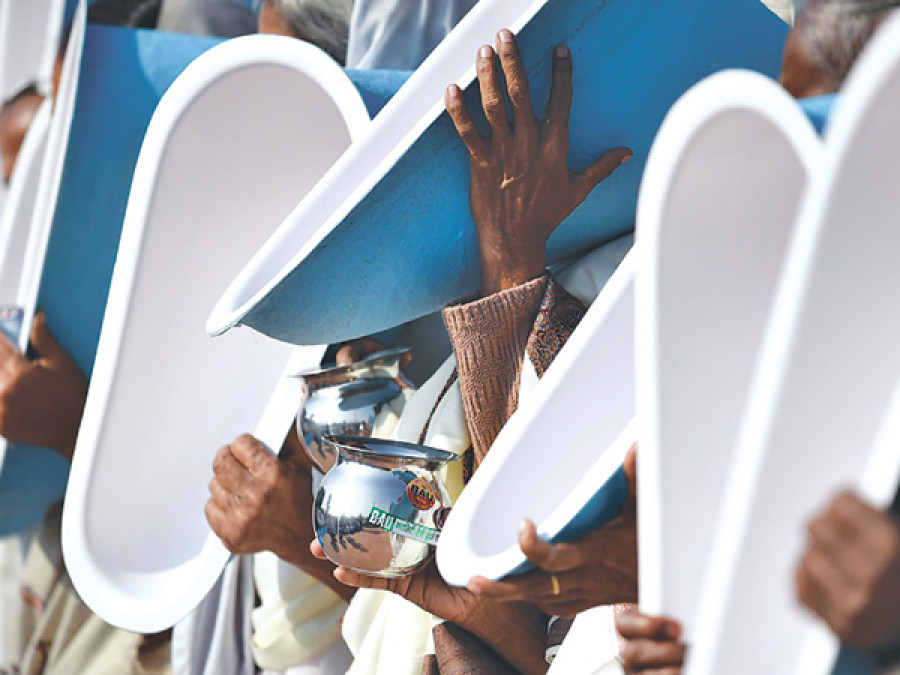Opinion
Toilet talk
We need to break the silence and talk about our defecation habits and how they affect our everyday life
Bicram Rijal
In July 2013, the United Nations General Assembly passed a resolution to designate November 19 as World Toilet Day urging member nations to make ‘sanitation for all a global development agenda’. This resolution by the UN brought together nations from across the world to recognise that sanitation and toilet should no longer be treated as a disgusting and marginal topic. As a result, the whole world is celebrating World Toilet Day today with both a hope and promise that open defecation will end and about a billion population worldwide—who currently lack a toilet/latrine—will have access to it and be able to relieve themselves privately and in a dignified way.
Gender dimension of toilets
As women without access to toilets are forced to relieve in the open areas—fields, riverside, roadside, alleyways—they face a greater risk of sexual violence, assaults, attacks (both human and animal), and may experience shame and embarrassment. To avoid these risks, they choose to go out in the open either during dawn or dusk for defecation. Still, there are reported incidents of attacks on women. In May 2014, the gruesome case of rape and hanging of two teenage girls in Uttar Pradesh had attracted the global attention. According to media reports, those girls were on their way to the fields for defecation. An article published in Economic and Political Weekly (August, 2015) titled ‘Understanding Issues Involved in Toilet Access for Women’ details the risks pertaining to health, personal security and safety, and dignity of women in Delhi’s urban slums due to insufficient sanitation infrastructures (particularly public toilets). The authors of this article found that women avoid eating and drinking in the evening so as to avert the possible visits to the toilets. Some women also told the researchers that they “feel scared and embarrassed in going to the toilet alone” and control their bladder as long as they can. The authors argue that harassment by men coupled with the filthy and stinky toilet infrastructures force some women to “not go to the toilet for three or four days at a stretch.” In developing countries, menstruating girls have also been found to avoid multiple school days every month due to poor or lack of toilet and water facilities at schools. Worse, researches also link higher rates of absenteeism and dropout among girl students with lack of gender-separate or deplorable toilets.
Sanitation and stunting
The link between poor sanitation and the incidents of waterborne diseases like diarrhea and typhoid is well known. According to World Health Organisation (WHO), diarrhea is the second leading cause of death of children under five and globally it kills as many as 760,000 children every year. Recent researches and reportings demonstrate the missing link between the practice of open defecation and stunted growth of children. A 2014 article titled ‘Poor Sanitation in India May Afflict Well-Fed Children With Malnutrition’, published in The New York Times argues that even relatively well-off and well-fed children in India are malnourished and stunted. And the major cause for this is the widespread practice of open defecation. This study assumes that stunting is more a problem of poor sanitation than a lack of food. The relatively higher rate of stunting in India compared to its African counterparts with similar or worse economic status—for example, Senegal, Uganda and Ghana—is attributed to its higher prevalence of open defecation. According to Joint Monitoring Programme report 2015 of the Unicef and WHO, more than half of the total population in India still defecates in the open.
Post-earthquake challenge
In Nepal, the rates of open defecation have declined significantly in the last few years due to rigorous and ‘coercive’ sanitation campaigns. But despite the fact that many people have built toilets/latrines, those involved in the campaigns worry about their continuous and sustainable use. Due to the earthquakes in April and May and an unofficial economic blockade imposed by India since late September, sanitation campaigns—with a goal of ‘sanitation for all’ by 2017—are likely to experience a huge setback. A friend of mine working in Dolakha district states, “Dolakha was on the verge of being declared Open Defecation Free district. Now, the earthquake has taken it many years back.” In the aftermath of the devastating earthquakes, however, the Nepali state is faced with both a new challenge and an opportunity to think anew not just about sanitation system, but also about infrastructure as a whole.
Beyond Toilet Day
While celebrating the World Toilet Day is symbolically important to spread the message about the significance of toilets and sanitation for healthy and dignified lives, the sanitation movement and media
coverage of it should not be limited to a single day. For Nepal and the world to achieve sanitation goals, sanitation and toilet should be part of everyday discourse and practice of development programmes of both the state and non-state actors alike. As Jack Sim, the founder of World Toilet Organisation, aptly points out in his Huffington Post piece (September 9, 2015), toilets need to be made “objects of desire” as mobile phones, televisions and automobiles are in today’s consumerist society. For this to happen, we need to break the silence and talk about toilets and defecation habits and how they affect our everyday life. This further signals the need for respective states and governments to prioritise sanitation just as they treat fields like health, communication, education and infrastructures to invest in. It is high time we made sanitation an exciting topic for research, policy, and development interventions than a taboo to be suppressed in public policy and conversation.
Rijal is a PhD Candidate in Anthropology at Simon Fraser University, Canada currently researching on sanitation campaigns in Nepal




 13.12°C Kathmandu
13.12°C Kathmandu










